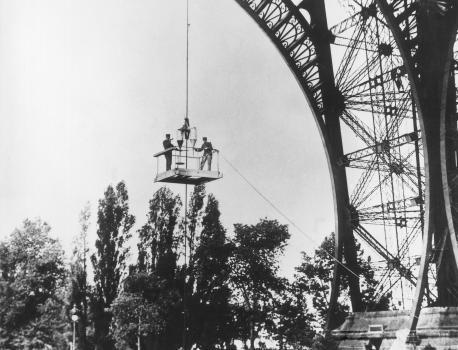Radio stationed itself atop the Eiffel Tower in 1898, breathing new life into it and saving it from destruction! But the Tower is also an integral part of the birth of television in France. Following a first test transmitting animated images over a long distance and the creation in 1931 of the General Television Company, an emitter was installed at the Tower’s summit in 1935. Emissions were regularly broadcast starting in 1937 and during that year’s World’s Fair.
In 1940, the German army took possession of the sabotaged emitter. Service wasn’t reestablished until May 1943. A television studio was purposely set up in close proximity, in Cognacq-Jay street. La Fernsehsender Paris directed by Kurt Hinzmann, former director of programming for Berlin television, began regular broadcasts for the occupying troops and in particular the military hospitals. A new Telefunken emitter was installed at the top of the Tower and was directly connected by a cable to Cognacq-Jay street. Broadcasts ceased on August 12, 1944, right before the liberation of Paris, and began again on the 1st of October with the recuperated equipment.
How the Tower grew up thanks television!
When the American troops returned control of the summit in October 1945, Radiodiffusion nationale, the future ORTF, began broadcasting again. Thanks to ever more powerful and sophisticated emitters, the Tower has always participated in the advancement of television broadcasting techniques: direct broadcasts, Eurovision, passage to 819 lines, and then all digital in the 2000’s. Originally 1024 feet high (312 meters), the Tower has “grown” 59 feet (18 meters) over time with the successive antennas installed at its summit. It now culminates to 1083 feet (330 meters).
Bertrand Lemoine is an architect, engineer and historian. He was a research director at the CNRS and general manager of the Atelier International du Grand Paris. He is an internationally recognized specialist in the history and current events of architecture, construction, the city and heritage in the 19th and 20th centuries, particularly in Paris, Greater Paris and the Eiffel Tower. He is the author of forty-three books and several hundred articles on these subjects. He is currently a consultant on architectural, urban, digital and energy issues.





